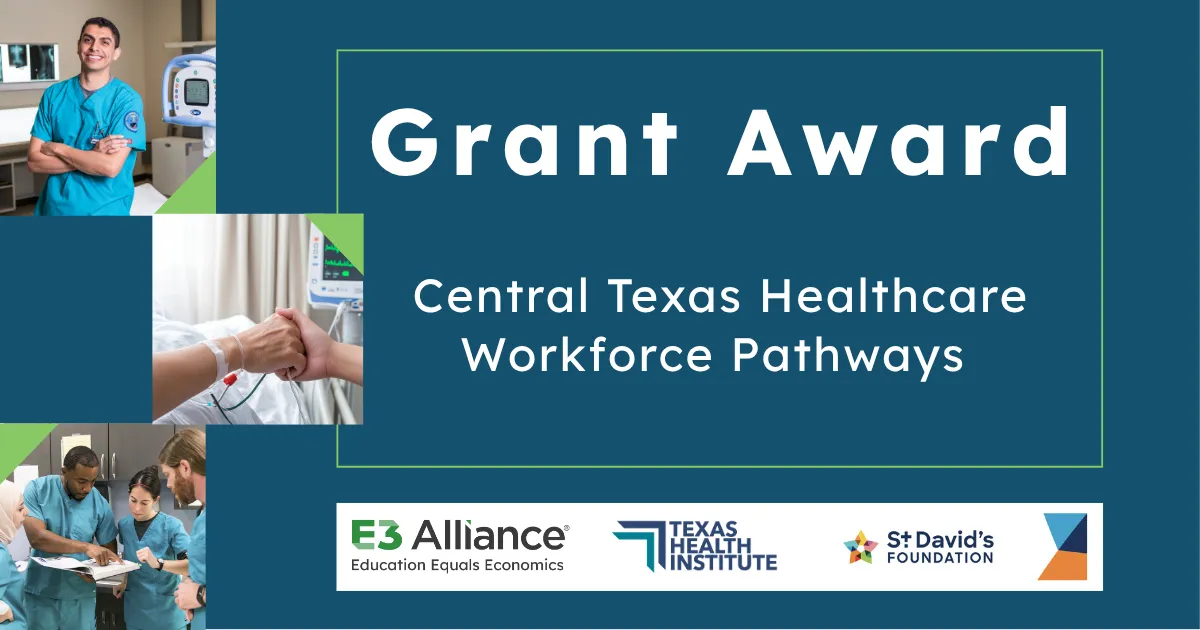$10M Investment Targets Healthcare Workforce Gaps in Central Texas

St. David’s Foundation funds 10-partner collaboration including E3 Alliance and Texas Health Institute
AUSTIN, TX (July 22, 2025) — St. David’s Foundation is investing over $10 million across 10 grants to strengthen the healthcare workforce in Central Texas. This initiative, part of the “Pathways to Economic Stability for the Healthcare Workforce” funding opportunity, aims to expand access to stable, high-demand healthcare careers, advancing health and economic opportunity throughout the region.
A cornerstone of this effort is the innovative collaboration between E3 Alliance (E3) and Texas Health Institute (THI). These organizations will jointly lead the E3/THI Central Texas Allied Healthcare Workforce Pathways to Economic Stability Initiative. This powerful partnership combines E3’s 19 years of experience in building regional career pathways and data-driven strategies with THI’s six decades of advancing health as an objective convenor, data-driven leader, and trusted community partner fostering systemic change.
“This visionary investment from St. David’s Foundation marks a new chapter for healthcare workforce development in Central Texas,” said Richard Tagle, president and executive director of E3 Alliance. “Applying our proven ‘cradle-to-career’ model to healthcare will create equitable pathways for underrepresented communities to access well-paying, sustainable careers. This collaboration can serve as a model for workforce development across the region.”
An E3 analysis shows that as Central Texas grows, demand for healthcare workers rises. However, Career and Technical Education (CTE), Pathways in Technology Early College High School (P-TECH), Early College High School (ECHS), and upskilling/reskilling programs are not scaling fast enough to meet the need. While the Dell Medical School, a planned specialty hospital, and other local programs are increasing capacity for medical school graduates, Austin Community College and local hospitals have identified significant shortages, particularly in surgical technicians, radiology technicians, paramedics, and health information technology.
The joint initiative will expand regionwide pathways to healthcare careers, particularly for underrepresented populations. It will strengthen partnerships among schools, higher education, employers, and community organizations. Expected outcomes include enrolling over 1,200 students annually into healthcare certification and credentialing programs, with a focus on clinical and community health roles. Furthermore, it will establish six new collaborative partnerships and expand four, uniting more than 30 organizations to transform healthcare training, social services, and community health.
Ankit Sanghavi, executive director of Texas Health Institute, expressed his enthusiasm, stating, “This is more than a workforce initiative, it’s a bold, community-driven effort to build a healthier, more equitable future for our region. Through this collaborative initiative alongside E3 alliance, we’re advancing a cross-sector strategy that not only strengthens the pipeline of well-trained, high-paying healthcare careers, but also creates real economic opportunities for communities that have long been overlooked. When we align systems around shared goals and center the voices of those most impacted, we don’t just create jobs, we invest in people, families, and the long-term vitality of our communities.”
THI research shows that significant gaps in the Central Texas healthcare workforce limit access to healthcare and complicate health outcomes, primarily due to a shortage of affordable, convenient, culturally response services. Workforce imbalances across the region worsen the issue, especially in communities that have not received sufficient investments and remain underrepresented.
Bridging the Central Texas healthcare workforce gap requires joint action and co-designed solutions that:
- Meet the industry’s demand for skilled, credentialed workers.
- Establish equitable pathways for obtaining those credentials.
- Engender ownership and trust in these pathways among underserved communities.
- Create a common vision among all stakeholders to promote shared accountability and collaboration for success.
This investment aligns with St. David’s Foundation’s 2030 Vision for Impact, which identifies the long-term change the Foundation wants to see in our community to advance health equity by supporting important work today, and driving toward systemic change tomorrow.
For more information about the “Pathways to Economic Stability for the Healthcare Workforce” funding opportunity and a full list of grant recipients, visit the St. David’s Foundation announcement.